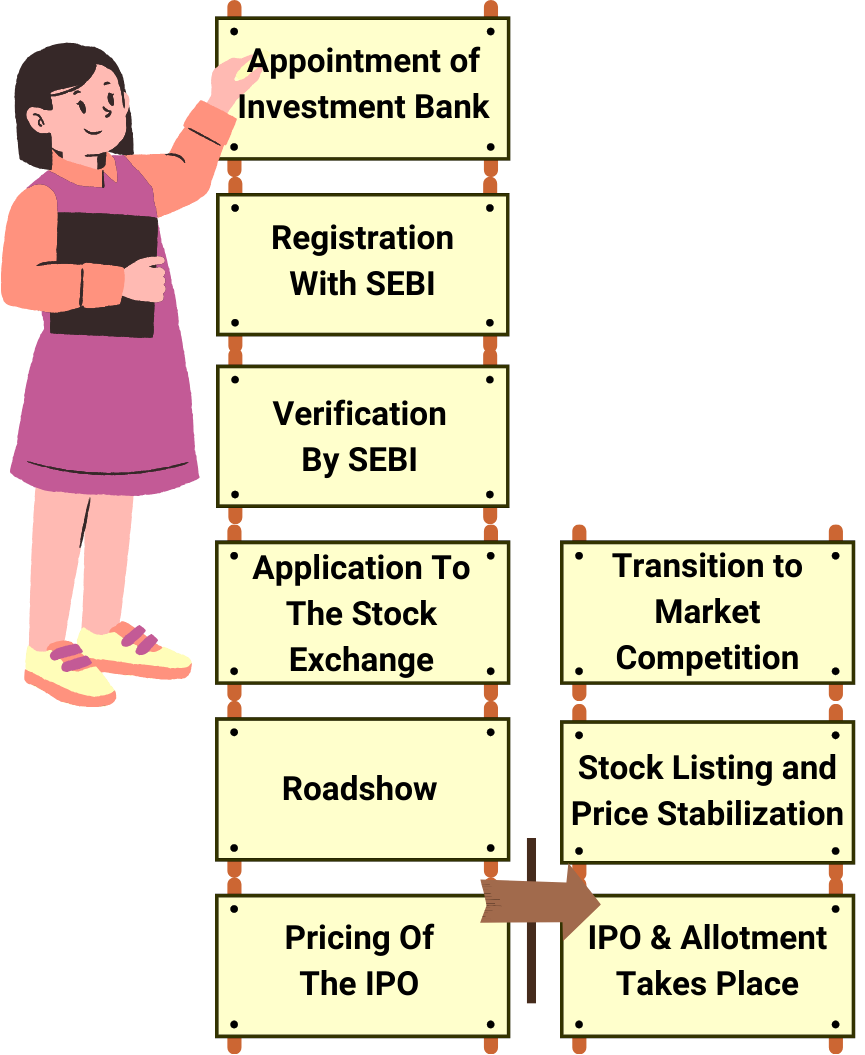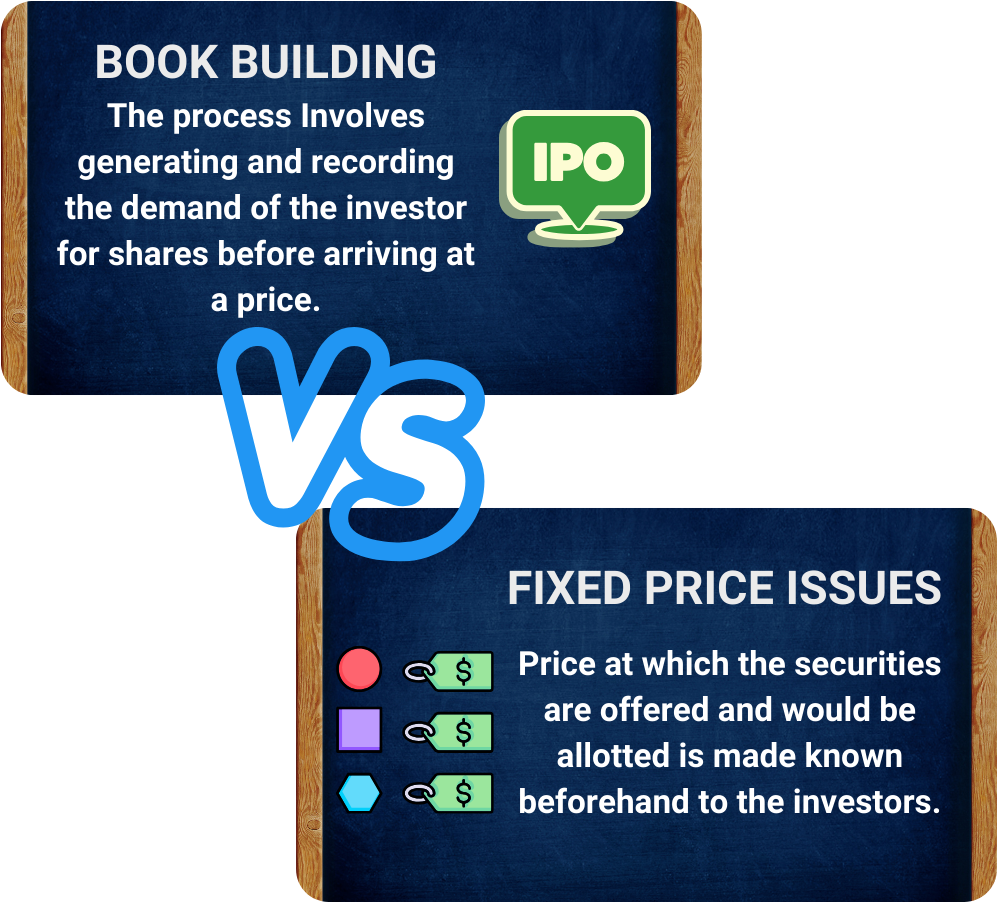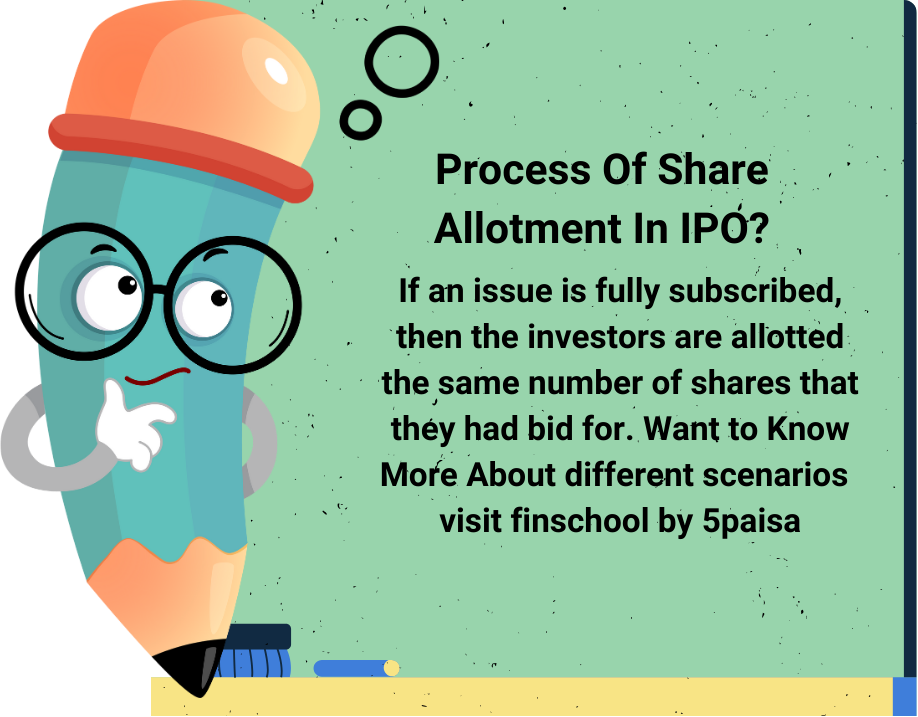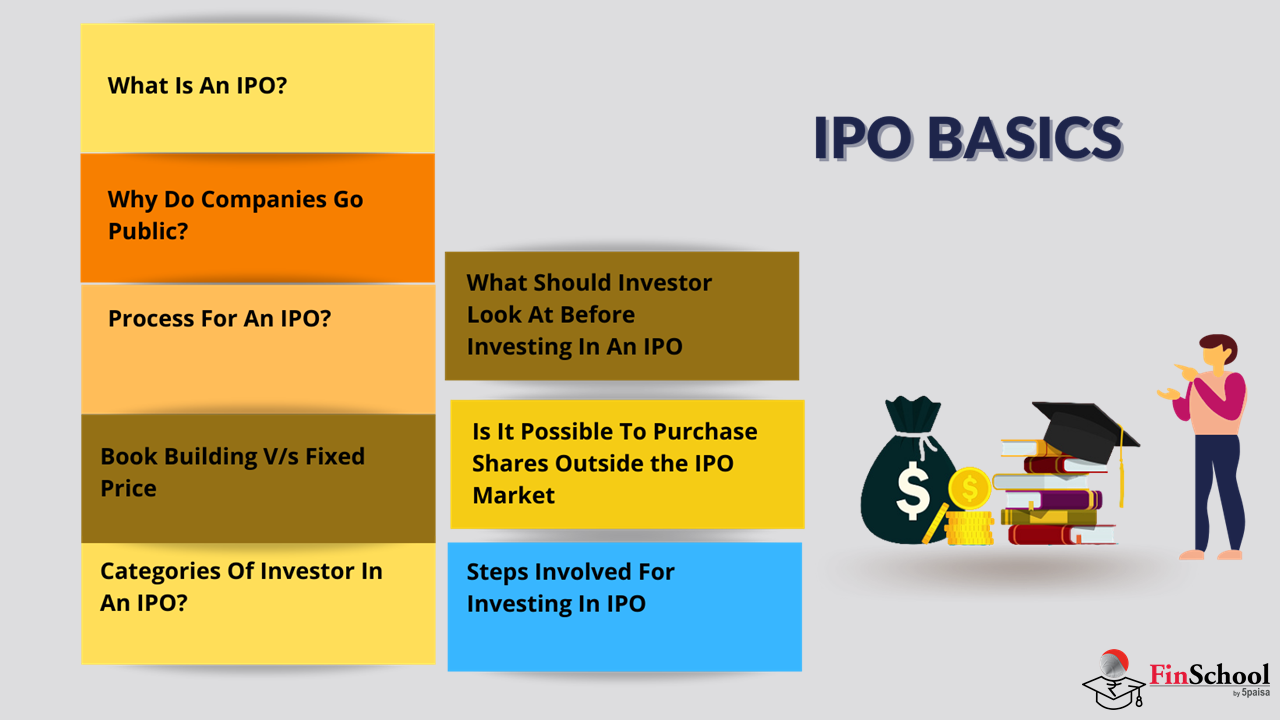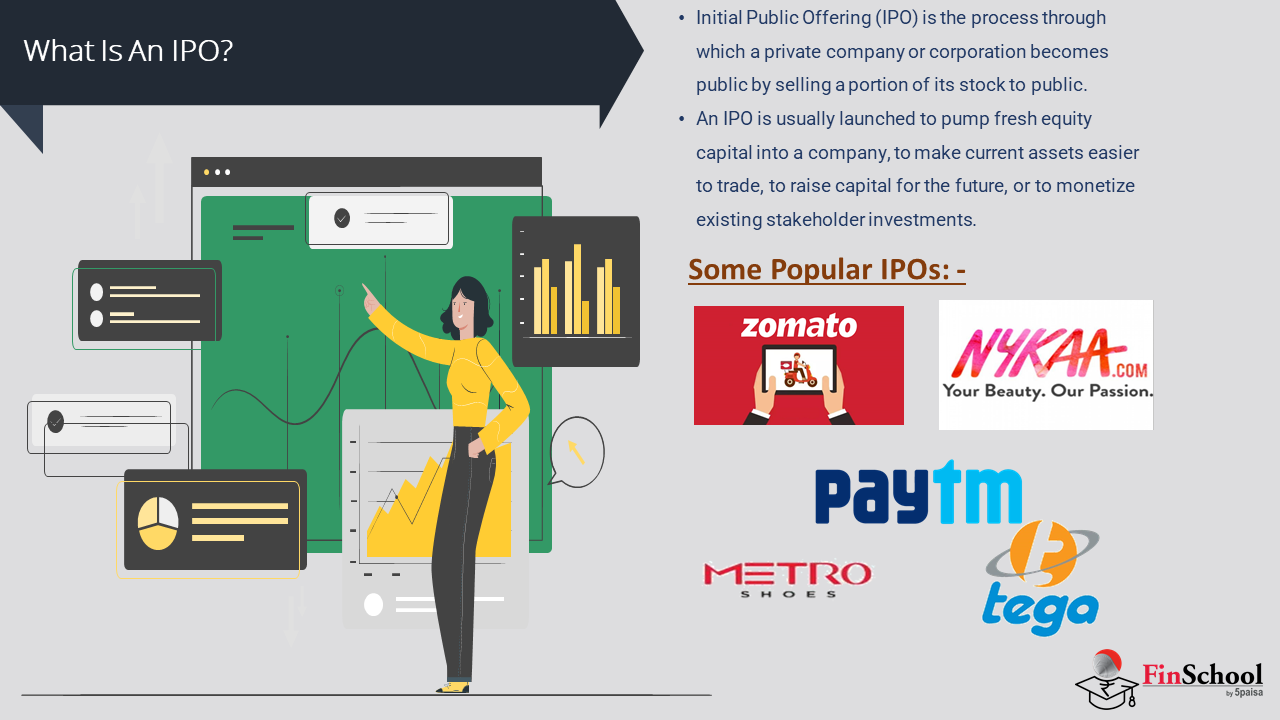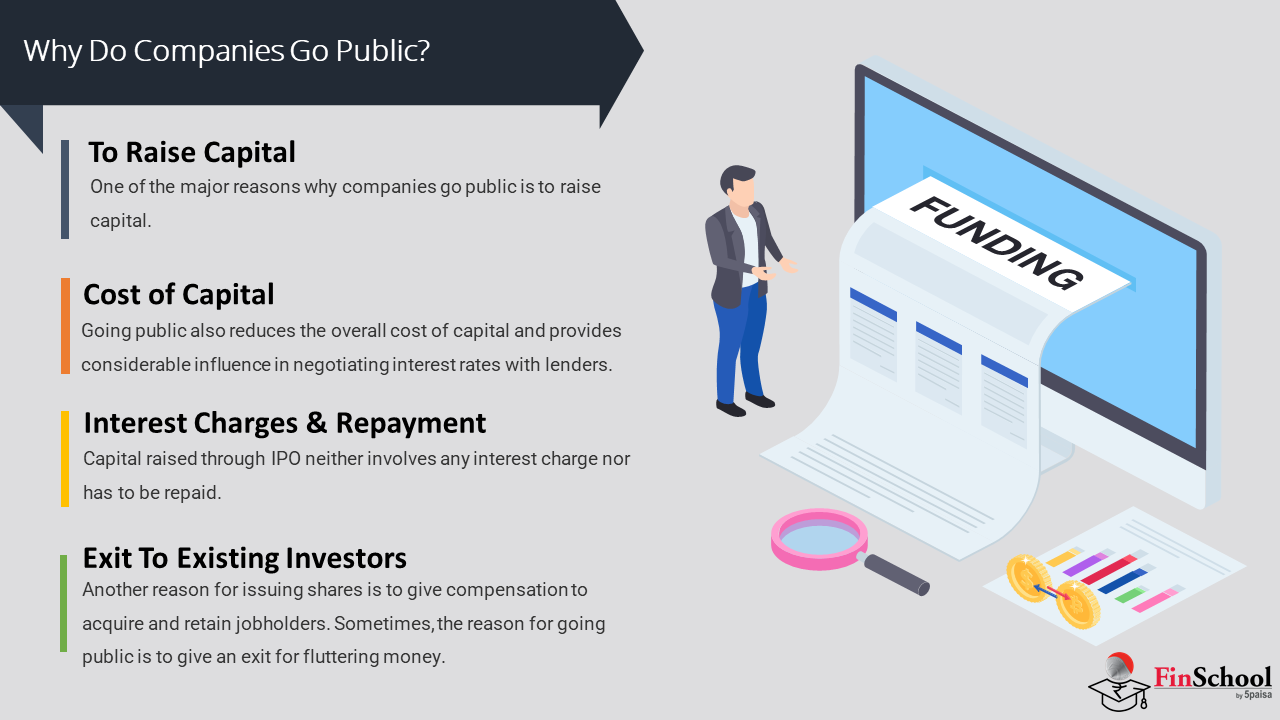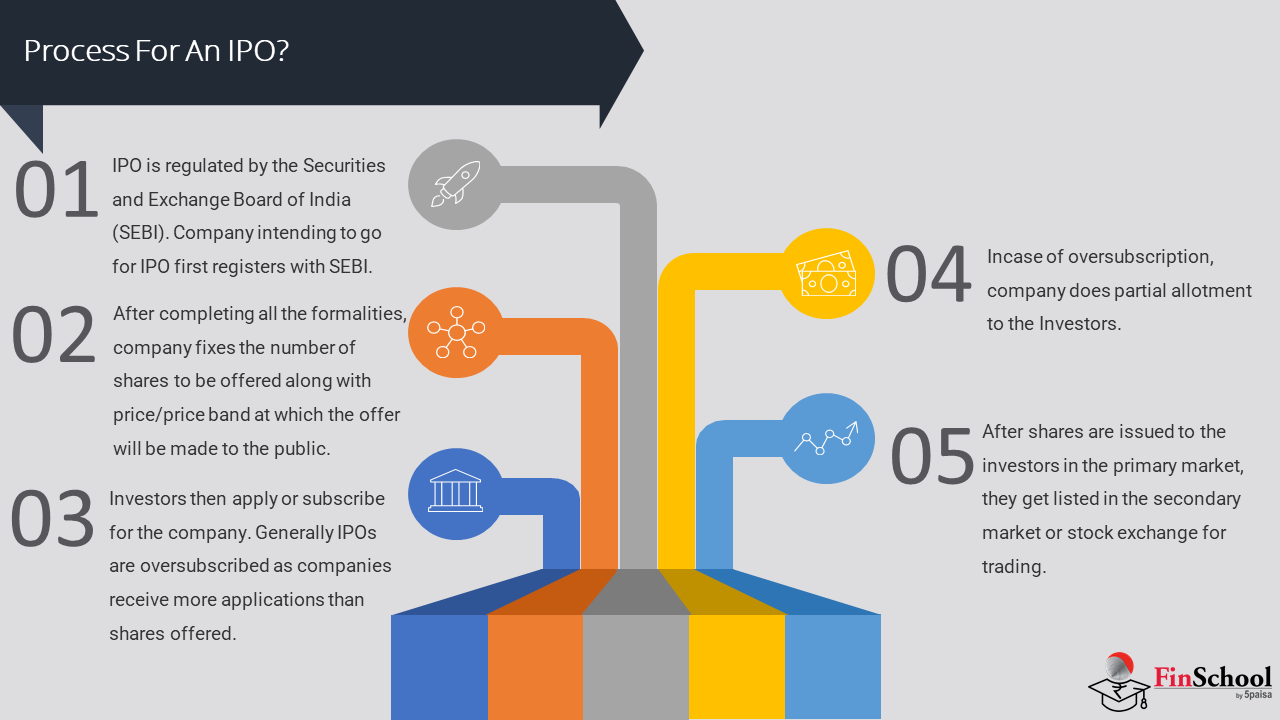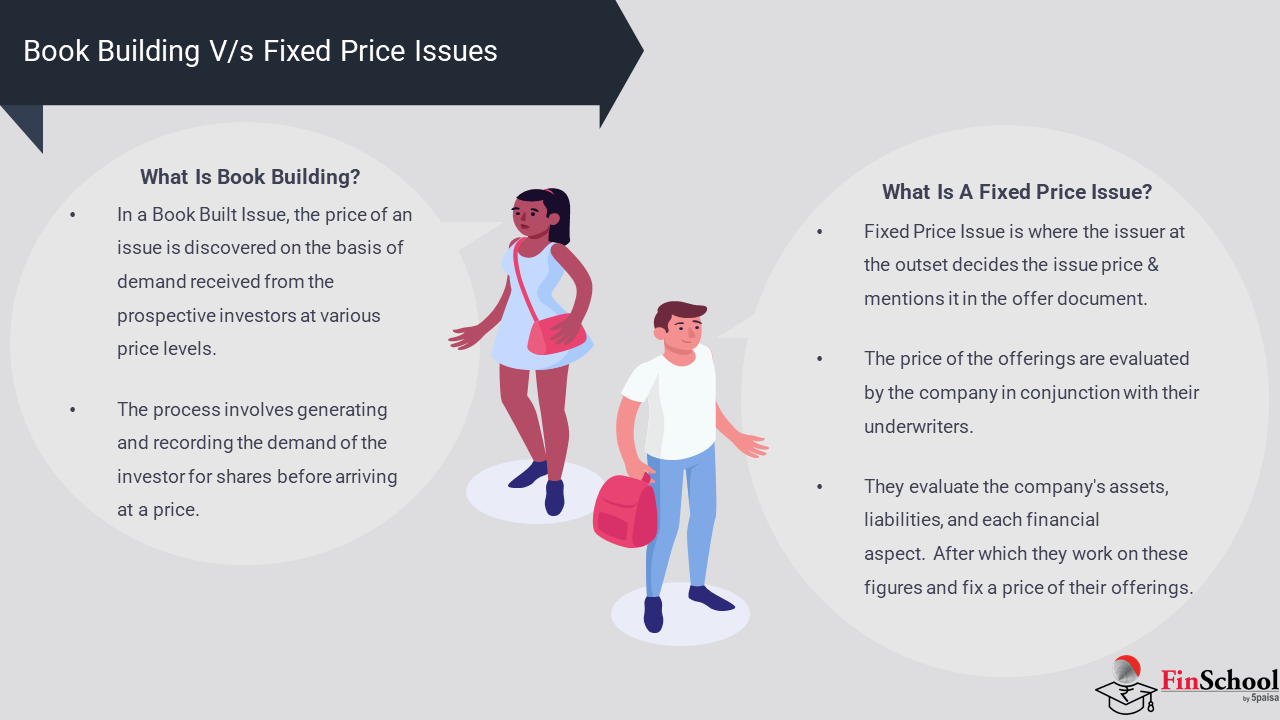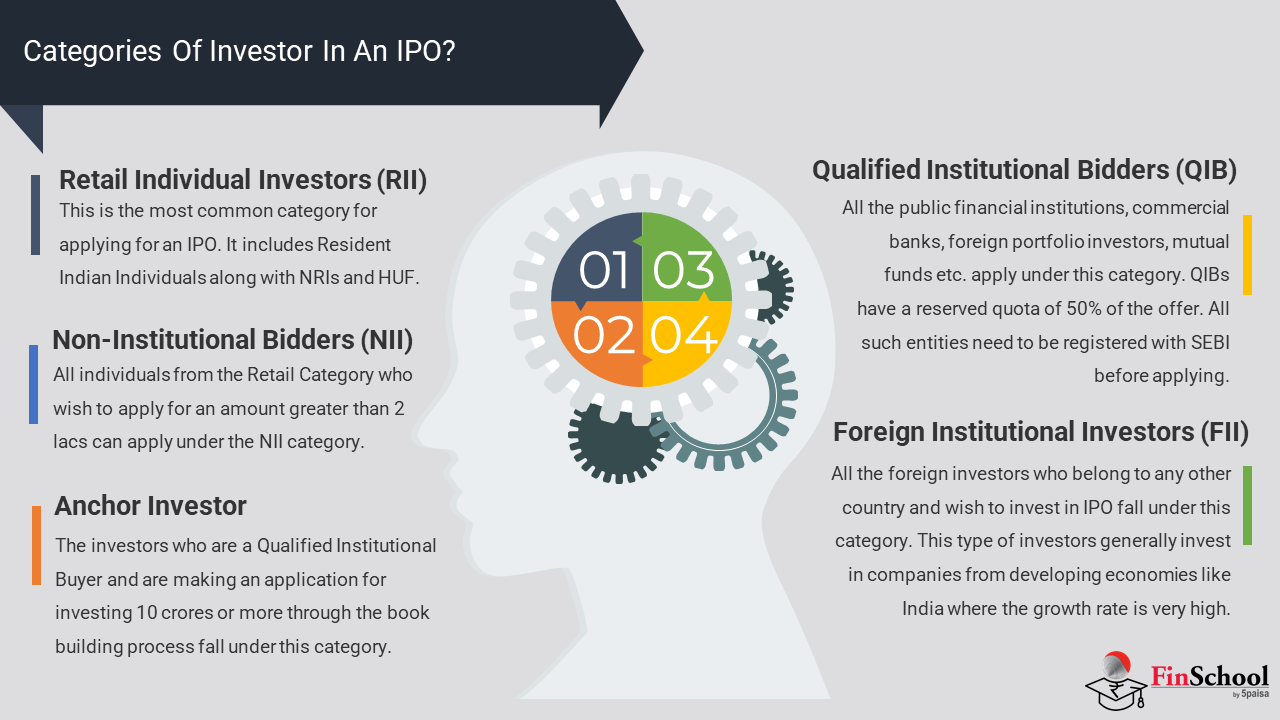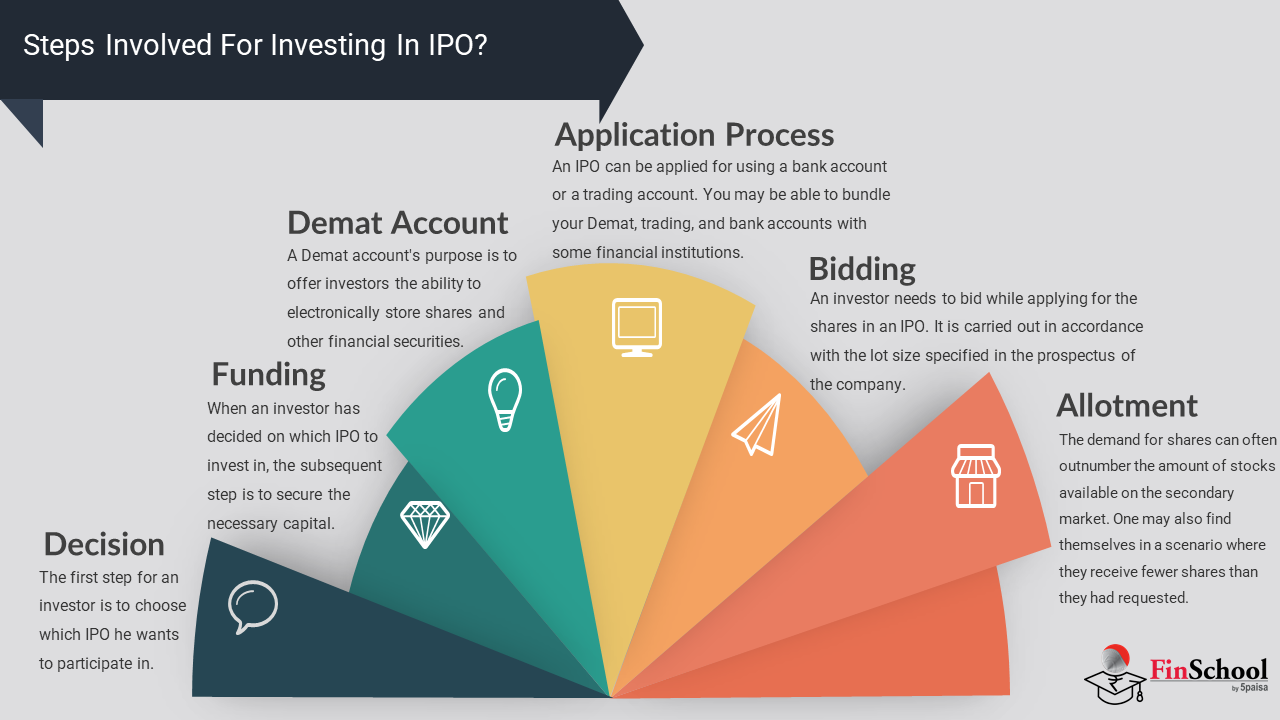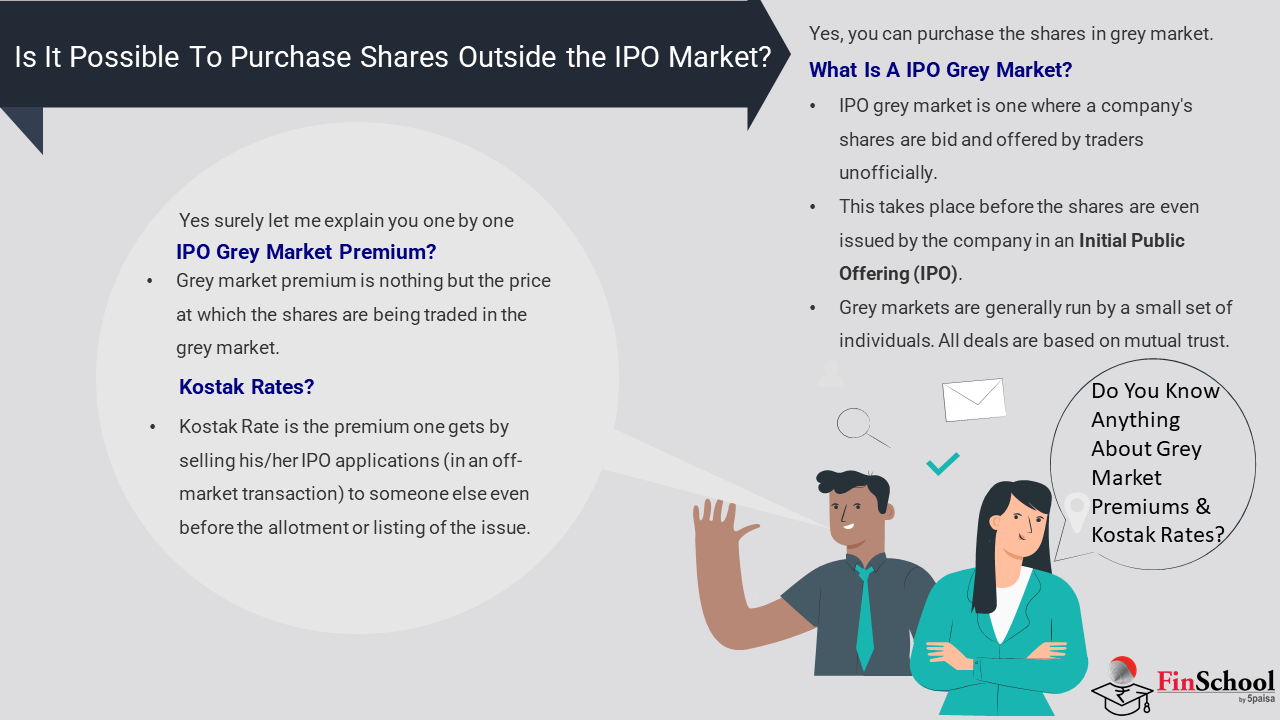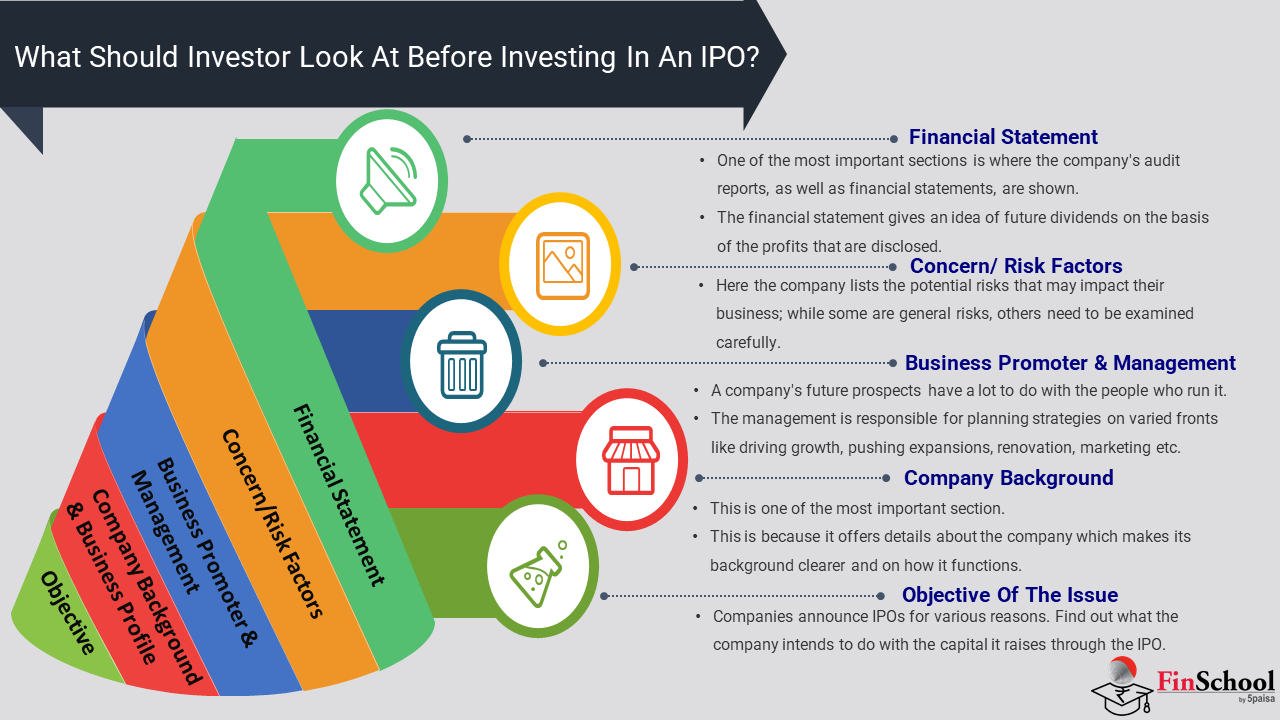- Study
- Slides
- Videos
4.1 What Is An IPO & Why Do Companies Go Public?

What Is An IPO?
The process through which a private company or corporation becomes public by selling a portion of its stock to public is known as an initial public offering (IPO). An IPO is usually launched to pump fresh equity capital into a company, to make current assets easier to trade, to raise capital for the future, or to monetize existing stakeholder investments. The company’s shares are listed and can be traded freely in the open market once the IPO is completed.
Why Do Companies Go Public?
One of the major reasons why companies go public is to raise capital. This capital is used by companies for the development and growth of their business. Additionally, going public also reduces the overall cost of capital and provides considerable influence in negotiating interest rates with lenders. Also, capital raised through IPO neither involve any interest charge nor has to be repaid.
Another reason for issuing shares is to give compensation to acquire and retain jobholders. Sometimes, the reason for going public is to give an exit for fluttering money.
4.2 Advantages Of Going Public & The Process For An IPO
Advantages Of Going Public:
- Money raised through IPO can be utilized by the company either for growth, expansion, acquisition, diversification or even to meet its working capital requirement
- Increasing liquidity of equity holders
- To Payoff existing debt
- International credibility & visibility
- Increase in market share
- Enabling cheaper access to capital
- Strengthening or Diversifying equity base
- Employee motivation & retention through stock option
Points To Understand On How Does An IPO Work:
- IPO is regulated by the securities and Exchange Board of India (SEBI). Company Intending to go for IPO first registers with SEBI.
- After completing all the formalities company fixes the number of shares to be offered along with price/price band at which the offer will be made to the public.
- Investors then apply or subscribe for the company. Generally IPOs are oversubscribed as companies receive more applications than shares offered.
- Incase of over subscription company does partial allotment to the Investors.
- After shares are issued to the investors in the primary market. It gets listed in the secondary market or stock exchange for trading.
4.3 What Is An IPO Procedure In India?
-
Appointment Of An Investment Bank
Once a company decides that it wants to go public, it needs to hire investment banks which are market intermediaries recognized by regulators. The investment banker understands the financial situation of the company and accordingly suggests them plans to meet their financial needs. They sign an underwriting agreement with the company. The agreement has all the details about the deal and the amount that will be raised by issuing securities. The companies may select an investment bank after determining various factors such as the reputation of the bank, expertise in the process, quality of their equity research and experience in the sector they deal. All these factors help in selling the IPO to the investors, traders and retailers.
-
Registration With SEBI
After the selection of the investment banker, the company is required to make an initial registration statement as per the regulations of the SEBI. In this process, the company and the underwriters submit the SEBI its fiscal data and the future plans of the company. The company is also required to give the declaration about the usage of funds that will be raised from IPO procedure. This declaration ensures that the company has given each and every disclosure that an investor must know. The company files for a draft red hearing prospectus (DRHP).
The DRHP includes key components about the company, its financials, its strengths, and risks, why it is raising funds and where will these funds be used. This document is prepared by the banks appointed as lead managers in coordination with the company. The DRHP is one of the most important documents as it acts as a source of information helping investors decide on whether they should invest in the company or not. This document is also used by the underwriters to market the IPO.
-
Verification By SEBI
After the prospectus is submitted the SEBI reviews the document. Here it ensures that every important detail about the company has been disclosed. If SEBI feels that adequate disclosures are not made or any errors exist then it is sent back to be changed. Then the company works on these issues and after making the required changes once again files for registration. Once the document is compliant with the guidelines set, SEBI allows the company to carry on with the IPO. The company going for an IPO is required to submit the Final Red Herring Prospectus at least 3 days before the offer is made available to the public for bidding.
Application To The Stock Exchange
The company files an application with the stock exchange where it plans to float the initial issue.
- Roadshow
Before the IPO goes public, this phase happens over an action-packed two weeks. The executives of the Company travel around the country marketing the upcoming IPO to the potential investors, mostly QIB. The agenda of the marketing includes presentation of facts and figures, which will drum up the most positive interest.
- Pricing Of The IPO
The company here has the option to either go for a Fixed Price IPO or a Book Building Issue. Under Fixed-Price IPO the price of the company’s stocks is set and announced beforehand. In a book building issue, the company sets a price band between which the investor can bid. Here the company sets an IPO Floor price which is the minimum price investors can bid and an IPO Cap price which is the maximum price they can bid. Based on this the highest price at which all the shares can be sold is determined.
- IPO & Allotment Takes Place
For a period that is usually 5 working days, the final prospectus and application forms are made available to the public both online and offline. Investors can apply for the IPO during this period. Once the price has finalised the company and the underwriters will work together to determine how many shares are to be allotted to each investor. This is done within 10 days of the last date of bidding. If the shares are oversubscribed then the remaining shareholders are refunded. During this step, it is also ensured that no shares are allotted to internal or related parties.
- Stock Listing and Price Stabilization
When the shares of the company are listed on the stock exchange and trading begins, the investment bank takes measures to establish the price of the securities. When there are not enough buyers, the bank will purchase the shares. The role of the investment bank in stabilizing the share price is essential. However, one must remember that such buying would last only for a short period of time because the IPO process already consumes a huge amount of capital investment.
- Transition to Market Competition
When the company’s transition period to the normal competitive environment is over, the company is required to make disclosures like its financial results, significant news, etc. that is material in nature and can affect the price of the shares. The role of the investment bank is still significant. It can continue as an advisor to the company and assist in increasing the price of the shares over a period of time.
4.4 Book Building Process vs Fixed Price Mechanism
Book Building
In the book building process when the IPO is open- bids are collected from investors at various Prices which can be above or equal to Floor price. The process Involves generating and recording the demand of the investor for shares before arriving at a price. Book building is the de facto mechanism by which companies price their IPOs and is highly recommended by all the main stock exchanges because it is the most effective thanks to price securities. The applicants bid for the shares quoting the worth and therefore the quantity that they might wish to bid at. The book is ‘built’ by listing and evaluating the aggregated demand received from the submitted bids. The underwriter analyzes the information and uses a weighted average to arrive at the final price for the security, which is termed the cutoff price. The underwriter has got to, for the sake of transparency, publicize the small print of all the bids that were submitted. Shares are allocated to the accepted bidders.
Fixed Price Issues–
Price at which the securities are offered and would be allotted is made known beforehand to the investors. The price of the offerings are evaluated by the company in conjunction with their underwriters. They evaluate the company’s assets, liabilities, and each financial aspect. They then work on these figures and fix a price for his or her offerings. The price is fixed after considering all the qualitative and quantitative factors. In the offer document, the issuer has to give the reasoning and proper justification for the price fixed. Generally, companies go for fixed price issue only when the management is of the opinion that a fair price can be decided among them without having tested in the market like in the case of book building.
Securities offered to public by Book Building Method or Fixed Price Method are often differentiated on parameters enumerated below:
- Pricing: – Within the Book Building Method, the worth at which securities are going to be offered/allotted isn’t known beforehand to the investor. Only an indicative price range is understood as Price Band. On the opposite hand, in Fixed Price Method, Price at which the securities are offered /allotted is understood beforehand to the investor.
- Demand: – Within the Book Building Method, demand for the securities offered are often known every day because the book is made while within the Fixed Price Method, demand for the securities offered is understood only after the closure of the difficulty.
- Payment: – Within the Book Building Method, payment is formed only after the allocation of securities to the investor. On the opposite hand in Fixed Price Method, payment is formed at the time of subscription of securities.
Categories Of Investor In An IPO-
- Retail Individual Investors (RII): This is the most common category for applying for an IPO. It includes Resident Indian Individuals along with NRIs and HUF. The investment amount under this category is capped at 2 lakhs. This category allows bidding at the cut-off price and minimum 35% of the offer is reserved for RII category.
- Non-institutional bidders (NII): All individuals from the Retail Category who wish to apply for an amount greater than 2 lacs can apply under the NII category. Minimum 15% of the offer is reserved for this category. Not less than 15% of the offer is reserved for non-institutional bidders. They enjoy the privilege to withdraw their bids until the day of allotment. However, they are not eligible to bid at cut-off price.
- Qualified Institutional Bidders (QIB): All the public financial institutions, commercial banks, foreign portfolio investors, mutual funds etc. apply under this category. All such entities necessarily need to be registered with SEBI before applying. QIBs have a reserved quota of 50% of the offer. They are not able to bid at cut off price and can neither withdraw their bids after the closing of the IPO.
- Anchor Investor: The investors who are a Qualified Institutional Buyer and are making an application for investing 10 crores or more through the book building process fall under this category. The issue price for Anchor Investors is decided separately. The minimum application size for Anchor Investors is 10 Crores and merchant bankers, promoters and direct relatives of them can’t apply under this category. They are not eligible to bid at the cut off price.
- Foreign Institutional Investors (FII): All the foreign investors who belong to any other country and wish to invest in IPO fall under this category. This type of investors generally invest in companies from developing economies like India where the growth rate is very high.
4.5 How Can Investors Invest In IPOs
Steps Involved For Investing In IPO: –
- Decision
The first step for an investor is to choose which IPO he wants to participate in. Though existing investors may have the necessary experience, new investors may find it intimidating. Investors can make a decision based on the prospectus of the companies that are launching an IPO.
The prospectus aids investors in forming an informed opinion about the company’s business plan and the reason for obtaining capital in the market. After making a decision, the investor must look ahead to the following step.
- Funding
When an investor has decided on which IPO to invest in, the subsequent step is to secure the necessary capital. An investor can buy a company’s stock with his funds.
If the investor does not have sufficient funds, he might take out a loan from a bank or a Non-Banking Financial Organization (NBFO) at a fixed interest rate.
- Setting up a DEMAT and trading account
An IPO cannot be applied for by anyone who does not have a Demat account. A Demat account’s purpose is to offer investors the ability to electronically store shares and other financial securities. Aadhaar card, PAN card, address, and identity proofs are required to open a Demat account.
- The application process
An IPO can be applied for using a bank account or a trading account. You may be able to bundle your Demat, trading, and bank accounts with some financial institutions.
After opening a demat-cum-trading account, an investor should get familiar with the Application Supported by Blocked Account (ASBA) facility. It is a requirement for all IPO applicants. The ASBA is a tool that allows banks to seize funds from an applicant’s bank account. The ASBA application forms are available in both demat and physical form to IPO candidates. Cheques and demand draughts, on the other hand, cannot be used to access the service. In the application, an investor must provide his or her demat account number, PAN, bidding data, and bank account number.
- Bidding
An investor needs to bid while applying for the shares in an IPO. It is carried out in accordance with the lot size specified in the prospectus of the company. The minimum number of shares that an investor must apply for in an IPO is referred to as the lot size.
A price range is established, and investors must bid within that range. Although an investor can change his bids during an IPO, it is important to remember that he must block the necessary cash while bidding. In the interim, the money held in the banks pays interest until the allotment procedure begins.
- Allotment
The demand for shares can often outnumber the amount of stocks available on the secondary market. One may also find themselves in a scenario where they receive fewer shares than they had requested. In these circumstances, the banks either fully or partially release the frozen funds.
However, if an investor is fortunate enough to acquire a full allotment, he will receive a CAN (Confirmatory Allotment Note) within six working days of the IPO’s completion. The shares are credited to the investor’s demat account when they have been allotted. Once the aforementioned stages have been completed successfully, the investor must wait for the equities to be listed on the stock exchange. It is usually completed within seven days of the shares being finalized.
4.6 How Are Shares Alloted?
Process Of Share Allotment
- Essentially, an allotment process is a way by which investors are issued the shares of the company whose IPO they subscribed to.
- The allotment is based on rules set by the Securities and Exchange Board of India (Sebi), the capital market regulator.
- For example, if an issue is fully subscribed, then the investors are allotted the same number of shares that they had bid for. Sebi insists that an issue must be subscribed at least 90 percent for it to list. If the issue falls short even after an underwriter’s assurances, the IPO is scrapped and the money is returned to bidders. Things get complex when an issue is oversubscribed – the number of applications is higher than the shares available for allotment.
- In the case of oversubscription, investors are keen to know how many shares they will finally get compared to the numbers they had bid for. In case of small oversubscription- the minimum lot will be distributed amongst all applicants and the remaining shares will be assigned proportionally to the investors who have bid for more than one lot.
- If there is large oversubscription that even one lot cannot be allotted to every applicant, then allotment takes places via lucky draw. This lottery draw will be computerized without any partiality. Thus, during large oversubscription, some names are not drawn in the lottery system, and shares are not assigned to many applicants.
4.7 What Should Investors Look Into Red Herring Prospectus?
Objective Of The Issue:
Companies announce IPOs for various reasons. Find out what the company intends to do with the capital it raises through the IPO. Does the company plan to reduce its debt, purchase new assets or meet its working capital needs? Also check the capital structure of the company to see if any big private investors have put money into the company.
Company Background & Business Profile:
This is one of the most important section. This is because it offers details about the company which makes its background clearer and on how it functions. Investors will get a better idea if they feel that the company’s business idea is actually worth it or not. In addition, the prospectus also includes information on the industry the company is in. This allows investors to assess what the future prospects of the company could be if the industry is actually growing and to what extent. The DRHP also informs investors about the company’s current competitors and its current position in the industry.
Business Promoter & Management:
A company’s future prospects have a lot to do with the people who run it. The management is responsible for planning strategies on varied fronts like driving growth, pushing expansions, renovation, marketing etc. This section has details such as names, qualifications, designations about directors, promoters and key management personnel. It may also have information about any criminal cases or that of financial delinquency or pending litigations against these people. It is important to check this section because all these can be a risk factor.
Concern/ Risk Factors:
Here the company lists the potential risks that may impact their business; while some are general risks, others need to be examined carefully. For example, pending legal cases are a factor that makes an IPO a very risky and therefore unviable investment. Potential investors should read this section closely to identify such risks.
Financial Statement:
One of the most important sections is where the company’s audit reports, as well as financial statements, are shown. The financial statement gives an idea of future dividends on the basis of the profits that are disclosed. As an investor, this information helps you assess the profitability and safety of your future investment.
4.8 What Is An IPO Grey Market?
- An IPO grey market is one where a company’s shares are bid and offered by traders unofficially. This takes place before the shares are even issued by the company in an Initial Public Offering (IPO).
- Since this is an unofficial market, there are no rules and regulations. Market regulators like Securities and Exchange Board of India (SEBI) are not involved in these transactions. The regulator doesn’t endorse this either.
- Grey markets are generally run by a small set of individuals. All deals are based on mutual trust.
What are Grey Market Premium & Kostak Rates?
- Grey market premium is nothing but the price at which the shares are being traded in the grey market.
- For instance, let’s assume the issue price for stock X is Rs 400. If the grey market premium is Rs 400, it means that people are ready to buy the shares of company X for Rs 800; (i.e. 400+400).
- Example of this works- Ridhi is a trader in the stock market. She is allocated 400 shares at a certain issue price in an upcoming IPO. Meanwhile there are other investors, called ‘buyers’, who think that the value of the share is much higher than its issue price.
- These buyers are ready to pay a ‘premium’ on the shares in the grey market. Dealers in the grey market contact investors like Ridhi, called ‘sellers’. They decide to make a deal to sell the shares at a certain price (premium) that is higher than the issue price. If Ridhi likes the deal and she is unwilling to take a risk with the stock’s listing, she sells her shares and books the profit.
- Kostak Rate is the premium one gets by selling his/her IPO applications (in an off-market transaction) to someone else even before the allotment or listing of the issue.



